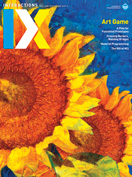Authors:
Gilbert Cockton, Simone Barbosa
In our second issue as editors-in-chief, we have furthered our five aims for Interactions: to extend support for HCI and interaction design (IxD) from more disciplines; to increase diversity and contributions from currently underrepresented groups (two "wider" aims); to address HCI history ("older"); to support discussion of trends in HCI and IxD; and to identify and discuss critical challenges for HCI and IxD communities (two "wiser" aims). Please visit http://interactions.acm.org/ to keep up to date with exclusively online content, such as our blogs. We also invite you to engage in conversations on issues raised throughout Interactions, through letters or via Facebook and Twitter. Discussion and debate are dear to us: We will be making Interactions more interactive over the next three years.
This issue introduces two new forum editors: Yunan Chen (Health Matters) and Nithya Sambasivan (The Next Billion). We welcome their fresh eyes on the challenges of health and underserved populations in emerging markets. We also most gladly take the opportunity to thank Gillian Hayes, Samuel Mann, and Elisa Giaccardi for their excellent contributions as longserving forum editors.
The cover story on HCI history tells the story of the Art Game, a previously unpublished design from the office of Charles and Ray Eames, and perhaps the earliest substantial interactive multimedia design. Bill Gaver and Kristina Höök continue their conversation about CHI design papers, providing concrete advice to aspiring authors about what they believe are the essential features of those papers. Jonathan Bean focuses on the challenge of fake news, enabled by our community's creations, with perspectives from literary theory. Elizabeth Churchill draws on finance and economics to discuss what return on investment (RoI) means for HCI or IxD. Shaowen Bardzell shares what she is reading, adding perspectives on utopia and emancipatory politics. Our visually led content (Demo Hour, Day in the Lab, How Was It Made?, Visual Thinking Gallery) further widen disciplinary contributions from fashion, materials, postcolonialism and remoteness, robotics, and synesthesia.
Our forums, visually led content, and columns include authors from Australia, France, Germany, Portugal, Spain, Sweden, the U.K., and the U.S. Our second aim of diversity is thus addressed, with further support from five features (plus a Brazilian touch right here). Neha Kumar and Susan Dray report on their CHI 2016 workshop aimed at envisioning a global, collaborative HCI agenda, discussing the path ahead for "HCI without borders," which they are advancing at their CHI 2017 symposium. Claudia Rebola and Grace Eden also report on participating at CHI 2016 remotely from the U.S. and Switzerland via Beam robots (artificial bodies that brought unexpected disabilities), prompting us to reflect on the likely experiences of those who can only attend conferences remotely, due to physical, financial, or political impairments (Loren Terveen's Community Square responds to some of the latter).
The other three features report on research from NordiCHI 2016, adding authors from the Netherlands and five Baltic countries. Ingrid Pettersson and Lena Hylving explore the challenges of digitalization for car manufacturing, discussing experiences at Volvo's human-machine interface (HMI) development group in Sweden, where they successfully formed arenas for cross-organizational collaborations by making HMI increasingly visible and tangible within a long-established manufacturer. Joanna Rutkowska and colleagues, from Senfino (Poland) and Tallinn (Estonia) and Delft Technical (Netherlands) universities, share lessons learned from creating and using tools to integrate design research into business-service or product-development processes, providing actionable results that fuel innovation. Anna Vallgårda and colleagues (Denmark and Norway) describe how material programming, which supports kinesthetic creative practices, might shape future IxD practices once graphene transistors make truly computational composites possible.
The features and cover story widen this issue's range of disciplines supporting HCI and IxD with robotics, product and graphic design, "development" policy, organizational studies, marketing, and consumer psychology. They address trends such as shifts from software to hardware and from engineering to creative design practices, as well as challenges from existing organizational, economic, political, and cultural structures and practices.
Gilbert Cockton and Simone Barbosa
[email protected]
Copyright held by authors
The Digital Library is published by the Association for Computing Machinery. Copyright © 2017 ACM, Inc.







Post Comment
No Comments Found